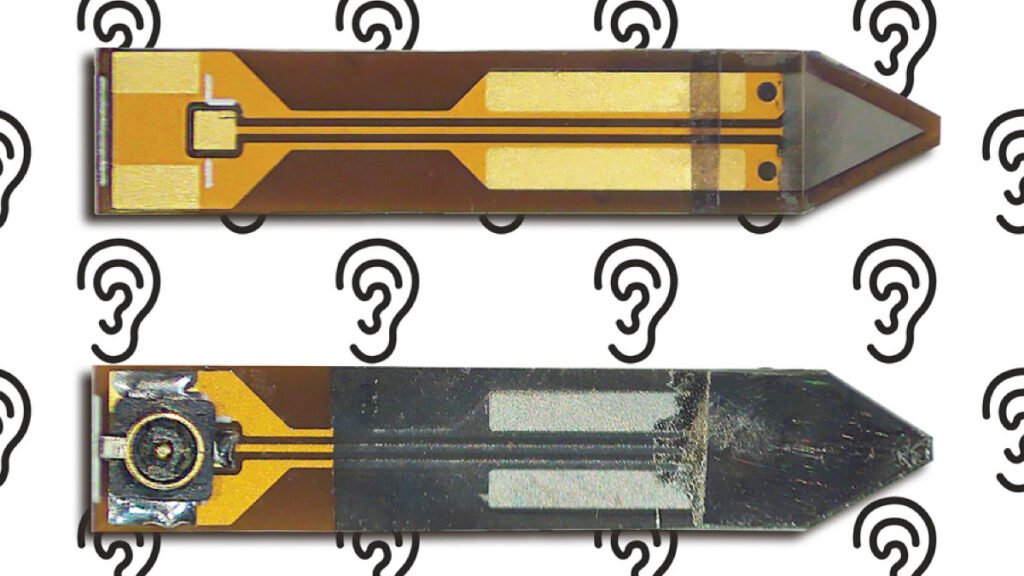We are getting closer to wholly internal cochlear implantable microphone thanks to a ground-breaking advancement in hearing technology that will completely change how people with hearing loss perceive the world.
A Revolutionary Step in Cochlear Implantable Microphone
The Massachusetts Institute of Technology (MIT) has made a significant breakthrough in the development of entirely internal cochlear implants: the invention of an implanted microphone. By addressing a major drawback of existing cochlear implants—which depend on external microphones and processors—this innovation enhances user usefulness as well as aesthetics.
The cochlear implants used today, which aid those with profound hearing loss, are made up of both internal and external parts. Sound is detected by the external microphone and processor, which then sends the signal to the internal device to activate the auditory nerve. These external parts, nevertheless, can be heavy, noticeable, and prone to breaking.
The implantable microphone developed by MIT researchers is a biocompatible, miniaturized device designed to be placed entirely within the ear. According to a report from All About Circuits, this innovative microphone is capable of picking up sound waves directly from within the ear, eliminating the need for external hardware. This approach not only simplifies the design of cochlear implants but also enhances user comfort and reduces the risk of device-related complications.
Advantages of the Implantable Microphone
- Removal of exterior Components: This innovation’s most notable benefit is the elimination of exterior components, which results in a more understated and user-friendly gadget. Customers no longer have to be concerned about their external microphones breaking, disappearing, or interfering with their everyday activities.
- Better Sound Quality: By recording sound from inside the ear, the implanted microphone may offer a more natural hearing experience. This could improve the sound’s fidelity and clarity, facilitating user communication.
- Enhanced Durability and Longevity: The implant’s inside housing protects it from external elements including moisture, dust, and physical impact, all of which can shorten its lifespan and require less maintenance.
- Enhanced Aesthetics: By making cochlear implants nearly undetectable to others, the entirely internal design greatly enhances their aesthetic appeal. The user may feel more at ease and confident in social settings as a result.
Potential Applications in Medical Devices
Beyond cochlear implants, the creation of an implanted microphone opens up new possibilities for medical devices:
- Advanced Hearing Aids: This technology could be modified to make entirely internal devices that are more user-friendly and productive for hearing aid users.
- Speech Recognition Systems: By integrating the implantable microphone into speech recognition aids, a more smooth and effective method of recording and processing speech can be provided.
- Neural prostheses: Other neural prostheses could benefit from the implantable microphone’s design, which would enhance its functionality and bodily integration.
Future Trends in Cochlear Implant Technology
Future trends in this field are anticipated to include the following as research and development continue to evolve:
- Integration with AI: Cochlear implants and artificial intelligence (AI) may be combined to provide more advanced sound processing and customized listening experiences depending on the user’s requirements and surroundings.
- Wireless Power Solutions: The development of wireless power transmission has the potential to significantly reduce the size of cochlear implants and improve user convenience by doing away with the need for batteries.
- Improved Connectivity: In the future, cochlear implants might have better connectivity with computers and cell phones, giving users access to a greater range of capabilities and more effective control over their hearing experience.
Conclusion
The creation of an implanted microphone is a significant step toward the realization of totally internal cochlear implants, which will provide enhanced longevity, aesthetics, and sound quality. This discovery offers intriguing new prospects for the development of medical devices in the future, in addition to improving the quality of life for people who have hearing loss. A better future for those with hearing loss is anticipated as advancements like AI integration and wireless power continue to develop and provide the possibility of more advanced and user-friendly hearing solutions.
